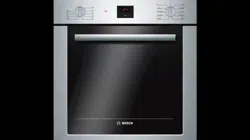Documents: Go to download!
User Manual
- User Manual - (English, French, Spanish)
- Installation Instructions - (English)
- Your new appliance
- Before using the oven for the first time
- Operation
- Cleaning and maintenance
- Before Calling for Service
- Tips for using your appliance
Table of contents
Owners' Guide Ovens
Your new appliance
Get to know your appliance. You will find information on the control panel, the oven, types of heating and accessories.
Oven
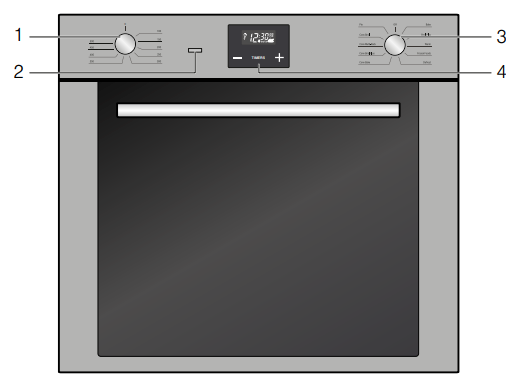
- Temperature selector
- Function lamp
- Function selector
- Display and function buttons
NOTICE: Do not place food directly on oven bottom. Do not obstruct oven vents.
Function selector
Use the function selector to set the type of heating.
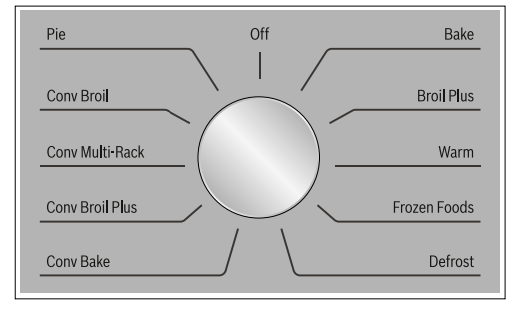
| Position | Use |
| Off | The oven is turned off |
| Bake | For cakes, casseroles and lean roast pieces. The heat comes evenly from the upper and lower heating elements. |
| Broil Plus | The heat coming from the broil element gives perfect broiling results above all for thin and medium thickness meat and in combination with the rotisserie (where present) gives the food an even browning at the end of cooking. Perfect for sausages, ribs and bacon. This function enables large quantities of food, particularly meat, to be broiled evenly. |
| Warm | The heat coming just from the bottom allows you to complete the cooking of foods that require a higher bottom temperature, without affecting their browning. Perfect for cakes, pies, tarts and pizzas. |
| Frozen Foods | The combination of fan-assisted cooking and traditional cooking allows different foods to be cooked on several levels extremely quickly and efficiently. Perfect for large volumes that call for intense cooking, useful not only for frozen, but also for fresh food. |
| Defrost | Rapid defrosting is helped by switching on the fan provided and the top heating element that ensure uniform distribution of low temperature air inside the oven. |
| Conv Bake | The operation of the fan, combined with traditional cooking, ensures uniform cooking even with complex recipes. Perfect for every type of food, even when simultaneously cooked on several levels. |
| Conv Broil Plus | The air produced by the fan softens the strong heatwave generated by the broil element, broiling perfectly even very thick foods. Perfect for large cuts of meat. |
| Conv Multi-Rack | The combination of the fan and the circular element (incorporated in the rear of the oven) allows you to cook different foods on several levels, as long as they need the same temperatures and same type of cooking. Hot air circulation ensures instant and uniform distribution of heat. For multiple level cooking we recommend using 2nd and 4th shelves. |
| Conv Broil | Through the combined action of the fan and the heat of the central element only, this function is perfect for rapid cooking and cooking au gratin of small quantites of food (particularly meats), by bringing together the dietary advantages of broiling and the even cooking of the fan. |
| Pie | The combination of the fan with lower heating and a little of top heating element allows cooking to be completed more rapidly. Perfect for any type of food, but in particular for pie and cakes. |
Note: When you set the heating function, the oven light in the cooking compartment switches on.
Temperature selector
Set the temperature using the temperature selector.
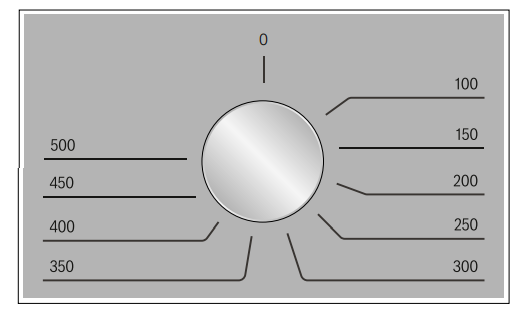

When the oven is heating, the display lamp blinks. When the set temperature has been reached, it lights up continuously and a signal sounds.
Timer
You can control your oven with the timer. This way you can select the time at which the oven should switch on or at which the timer should end the baking or cooking process. The timer can also be used as a short-term timer.
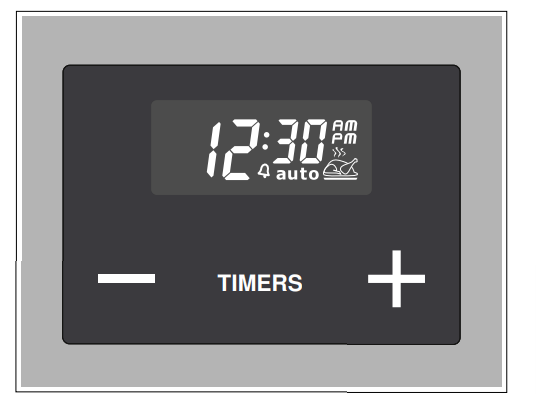
Function buttons
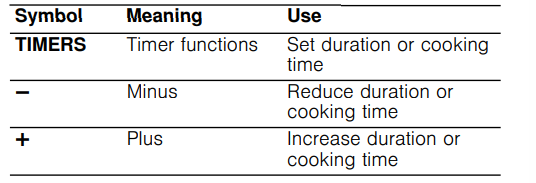
Display symbols

Accessories
The accessories can be inserted into the cooking compartment at 5 different levels.Always insert them as far as they will go so that the accessories do not touch the door panel. Ensure that you always insert the accessories into the cooking compartment correctly.
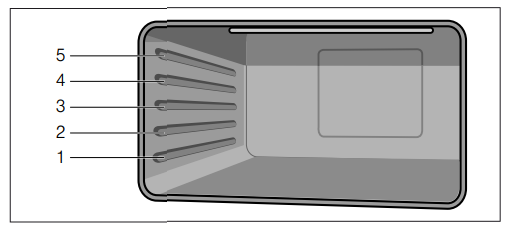
You can pull out the accessories two thirds of the way without them tipping. This allows meals to be removed easily.
The accessories may become deformed when they become hot. As soon as they have cooled down, the deformation disappears with no effect on the function. You can buy accessories from customer service, from specialist retailers or online.
The pull-out rails allow you to pull accessories out completely.
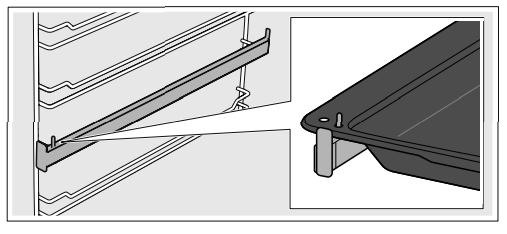
| Accessories | Explanation |
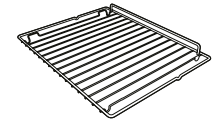 |
Baking and roasting shelf For ovenware, cake tins, roasts, broiled items, frozen meals. |
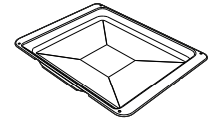 |
Enamel baking tray For moist cakes, pastries, frozen meals and large roasts. Can also be used as a drip tray to collect run-off fat. |
 |
Locking pins For locking the hinges. |
 |
Roof liner The roof liner can be inserted permanently above the oven broil element to avoid soiling of the cavity roof. It is removable and coated with porcelain enamel to facilitate cleaning. Note: : The porcelain coverage on the roof liner is not even, some areas will have a less shiny surface. This is normal, the metal is still covered and protected. |
Inserting the roof liner
Insert the roof liner by carefully sliding it in above the broil element. To remove it pull it carfully out of the oven cavity.

Before using the oven for the first time
In this section, you can find out what you must do before using your oven to prepare food for the first time. Read the Safety information section beforehand. Remove the appliance packaging and dispose of it appropriately.
Setting the time
After connecting the oven or after a power failure,  and auto will blink on the display.
and auto will blink on the display.
- Hold the TIMERS button down until the colon blinks on the display.
- Set the current time with the + and - buttons. Hold the + or - button down to change the value faster. The time set is taken over after 5 seconds.
Setting the time during operation
- Hold the + and - button down until the colon blinks on the display.
- Set the current time with the + and - buttons. Hold the + or - button down to change the value faster. The time set is taken over after 5 seconds.
Baking out the oven
Pre-cleaning the oven
- Remove the accessories, the hook-in racks and the roof liner from the cooking compartment.
- Completely remove any leftover packaging, e.g. small pieces of polystyrene, from the cooking compartment.
- Some parts are covered with a protective film. Remove this scratch protection film.
- Clean the outside of the appliance with a soft, damp cloth.
- Clean the cooking compartment with hot soapy water.
Heating up the oven
To remove the new smell, heat up the oven when it is empty and closed.
- Turn the function selector to the Bake operating mode.
- Turn the temperature selector to the maximum temperature.
- Switch the oven off after 40 minutes.
Re-cleaning the oven
- Clean the cooking compartment with hot soapy water.
- Refit the hook-in racks.
Cleaning the accessories
Before using the accessories, clean them thoroughly using a cloth and warm soapy water.
Operation
Switching on the oven
- Use the function selector to set the type of heating.
- Use the temperature selector to set the temperature. The oven begins to heat up.
Switching off the oven
Turn the function selector and temperature selector to the off position.
Changing settings
The heating function and temperature or broil setting can be changed at any time using their respective selectors.
Heating up
In order to heat up the cooking compartment as quickly as possible, use the "Conv Bake" heating type. When the set temperature has been reached (indicator light lights up continuously and signal sounds), set the desired heating type.
Kitchen timer
The short-term timer has no influence on the functioning of the oven. The duration of the short-term timer can be set from 1 minute to 23 hours and 59 minutes.
- Hold the TIMERS button down until the
 blinks and
blinks and  is displayed.
is displayed. - Set the desired duration with the + and - buttons. The set time is taken over after 5 seconds. After the time has elapsed, a signal sounds and the
 symbol blinks.
symbol blinks.
Note: While the short-term timer is running, the time is displayed and the  symbol lights up continuously.
symbol lights up continuously.
Changing the set time:
To change the remaining time, hold the TIMERS button down until the  symbol blinks on the display. Then change the remaining time with the + and - buttons.
symbol blinks on the display. Then change the remaining time with the + and - buttons.
Canceling the short-term timer
To delete the setting, hold the TIMERS button down until the  symbol blinks on the display.Then press the + and - buttons simultaneously.
symbol blinks on the display.Then press the + and - buttons simultaneously.
Switching the signal tone off
Hold the TIMERS button down until the clock disappears. After seven minutes, the signal switches off automatically.
Setting the automatic timer
With the TIMER function, you can set an operating time duration or program a start and end time.
Automatic switch-off
- Press the TIMERS button down until the
 symbol blinks.
symbol blinks. - Press the TIMERS button again. On the display, auto and
 blink.
blink. - Use the + and - buttons to set the operating time duration. The operating time duration can be set from 1 minute to 10 hours.
- Set the desired heating type and temperature. The oven starts. The
 and auto signals light up on the display, the current time is displayed.
and auto signals light up on the display, the current time is displayed.
The operating time duration has elapsed A signal sounds, auto blinks on the display.
- Switch off the temperature selector and function selector.
- Hold the TIMERS button down until the
 symbol appears. The oven switches back to manual mode.
symbol appears. The oven switches back to manual mode.
Canceling the operating time duration
To delete the setting, hold the TIMERS button down until the  symbol blinks on the display. Then press the + and - buttons simultaneously.
symbol blinks on the display. Then press the + and - buttons simultaneously.
Automatic switch-on and switch-off
Baking or roasting starts for the set duration at a later time which you chose.
- Press the TIMERS button down until the
 symbol blinks.
symbol blinks. - Press the TIMERS button again. On the display, auto and
 blink.
blink. - Use the + and - buttons to set the operating time duration. The operating time duration can be set from 1 minute to 10 hours.
- Press the TIMERS button again. auto and the
 symbol blink on the display. The end time for the programmed operating time duration is displayed.
symbol blink on the display. The end time for the programmed operating time duration is displayed. - Adjust the end time with the + and - buttons. The end time can be set up to 23 hours and 59 minutes. The oven calculates the start time. After 5 seconds, the time set is taken over. The
 and auto signals go out, the current time is displayed.
and auto signals go out, the current time is displayed. - Set the desired heating type and temperature. The oven will begin to heat at the calculated start time. On the display, the
 and auto symbols light up.
and auto symbols light up.
The operating time duration has elapsed A signal sounds, auto blinks on the display.
- Switch off the temperature selector and function selector.
- Hold the TIMERS button down until the
 symbol appears. The oven switches back to manual mode.
symbol appears. The oven switches back to manual mode.
Canceling the operating time duration
To delete the setting, hold the TIMERS button down until the  symbol blinks on the display. Then press the + and - buttons simultaneously.
symbol blinks on the display. Then press the + and - buttons simultaneously.
Basic Settings
You can always make the following basic settings:
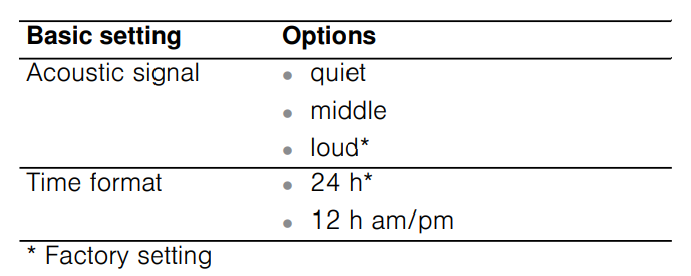
Adjust the signal volume
The oven must be switched off.
- Hold the + and - button down until the colon blinks on the display.
- Press the TIMERS button again. Signal appears on the display.
- Press the - button repeatedly until the required volume is reached.
Changing the time format
The oven must be switched off.
Press and hold the + button for 3 seconds  appears on the display. To change to the 24 h time format, hold the + button down again for 3 seconds.
appears on the display. To change to the 24 h time format, hold the + button down again for 3 seconds.
Cleaning and maintenance
With good care and cleaning, your oven will remain clean and fully-functioning for a long time to come. Here we will explain how to maintain and clean your oven correctly.
Notes
- Slight differences in the colors on the front of the oven are caused by the use of different materials, such as glass, plastic and metal.
- Shadows on the door panel that look like streaks, are caused by reflections made by the oven light.
- Enamel is baked on at very high temperatures. This can cause some slight color variation. This is normal and does not affect operation. The edges of thin trays cannot be completely enameled. As a result, these edges can be rough. This will not impair the anticorrosion protection.
WARNING
RISK OF ELECTRICAL SHOCK
Moisture entering the appliance can cause an electrical shock. Don't use a high-pressure cleaner or steam cleaner.
WARNING
RISK OF BURNS
The appliance becomes very hot. Never touch the hot inside surfaces of the oven interior or heating elements. Always allow the appliance to cool down. Keep children away.
Cleaning agents
Observe the following information to ensure that the different surfaces are not damaged by using the wrong type of cleaning agent.
Do not use:
- any harsh or abrasive cleaning agents,
- cleaning agents with a high concentration of alcohol,
- hard scouring pads or sponges,
- high-pressure cleaners or steam cleaners.
Wash new sponge cloths thoroughly before use.
| Area | Cleaning agents |
| Appliance exterior | Hot soapy water: See other models: HBL8752UC HBLP752UC HMCP0252UC HBL87M52UC HMC80252UC Clean with a dish cloth and dry with a soft cloth. Do not use glass cleaner or a glass scraper. |
| Stainless steel | Hot soapy water: Clean with a dish cloth and dry with a soft cloth. Remove flecks of lime scale, grease, starch and albumin (e.g. egg white) immediately. Corrosion can form under such flecks. Special stainless steel cleaning products suitable for hot surfaces are available from our customer service or from specialist retailers. Apply a very thin layer of the cleaning product with a soft cloth. |
| Aluminum and plastic | Glass cleaner: Clean with a soft cloth. |
| Enamel surfaces (smooth surfaces) | To facilitate cleaning, you can switch on the interior lighting and detach the appliance door if necessary. Apply commercially available dishwashing liquid or a vinegar solution with a soft, damp cloth or chamois; dry with a soft cloth. Soften bakedon food residues with a damp cloth and detergent. Leave the cooking compartment open to dry after cleaning. |
| Self-cleaning surfaces (rough surfaces) | Please see the notes in section: Selfcleaning surfaces |
| Door panels | Glass cleaner: Clean with a soft cloth. Do not use a glass scraper. |
| Glass cover for the oven light | Hot soapy water: Clean with a dish cloth. |
| Seal Do not remove. | Hot soapy water: Clean with a dish cloth. Do not scour. |
| Rails | Hot soapy water: Soak and clean with a dish cloth or brush. |
| Accessories | Hot soapy water: Soak and clean with a dish cloth or brush. |
| Roof liner | Hot soapy water: Soak and clean with a dish cloth or brush. Remove from oven for cleaning |
Catalytic cooking compartment panels
The catalytic cooking compartment panels are coated with self-cleaning enamel. The surfaces clean themselves while the oven is in operation. Larger splashes will only be removed after the oven has been used several times.
Self-cleaning surfaces
The rear and side walls are covered with catalytic paneling. So not use oven cleaner on the catalytic panels. Slight discoloration of the enamel does not affect self-cleaning.
Removing and installing the door panels
To facilitate cleaning, you can remove the glass panels from the oven door.
Removing the door panels
- Open the oven door fully.
- Lock both hinges on the left and right using a locking pin.
Note: The locking pins must be fully inserted into the holes in the hinges.
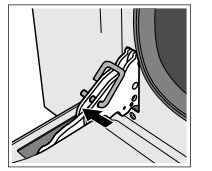
- Lift the bottom of the inner panel slightly until the fastening pins come out of the holder (1).
- Carefully lift the top of the inner panel until the fastening pins come out of the holder (2).
CAUTION When lifting the inner panel, the middle panel may stick to the inner panel. Make sure that the middle panel does not fall.
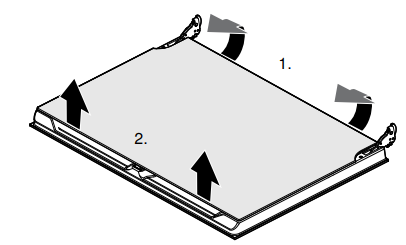
- Remove the inner panel.
- Remove the middle panel.
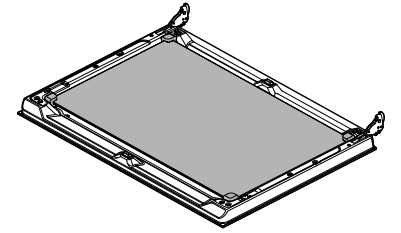
Note: The middle panel is kept in place with rubber bushings rather than retaining pins.

Clean the panels with glass cleaner and a soft cloth.
WARNING
RISK OF INJURY
Scratched glass in the appliance door can burst. Do not use any glass scrapers or strong or abrasive cleaning agents.
Fitting the door panels
- Reinsert the middle panel.
Note: Make sure that the panel is seated correctly.All rubber bushings must lay flat against the outer panel. - Reinsert the inner panel.
Note: All four fastening pins must engage in the holders provided for them. - Remove the locking pins and close the oven door.
Removing and fitting the appliance door
In case of especially heavy soiling, the oven door can be removed for better cleaning. Normally, however, this is not necessary.
CAUTION
WHEN REMOVING THE OVEN DOOR:
- Make sure oven is cool and power to the oven has been turned off before removing the door. Failure to do so could result in electrical shock or burns.
- The oven door is heavy and parts of it are fragile. Use both hands to remove the oven door. The door front includes glass components. Handle carefully to avoid breakage.
- Grasp only the sides of the oven door. Do not grasp the handle as it may swing in your hand and cause damage or injury.
- Failure to grasp the oven door firmly and properly could result in personal injury or product damage.
- To avoid injury from hinge bracket snapping closed, be sure that both locking levers are securely in place before removing the door. Also, do not force the oven door open or closed - the hinge could be damaged and injury could result.
- Do not lay the removed door on sharp or pointed objects as this could break the glass. Lay the door on a flat, smooth surface, positioned so that the door cannot fall over.
Removing the appliance door
- Open the oven door fully.
- Lock both hinges on the left and right using a locking pin (a).
Note: The locking pins must be fully inserted into the holes in the hinges. - Grip the oven door on either side with both hands and close the oven door by approx. 30° (b).
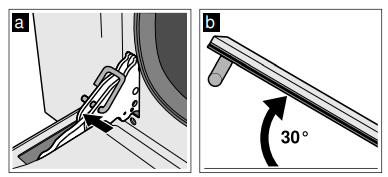
- Raise the oven door slightly and pull it out.
Note: Do not fully close the oven door. The hinges could become bent and the enamel could be damaged.
Fitting the appliance door
- Grip the oven door on either side with both hands.
- Slide the hinges into the slots in the oven (a).
Note: The notch below the hinges must engage into the frame of the oven (b).
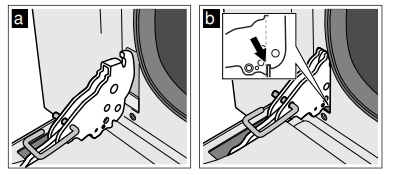
- Lower the door downwards.
- Remove the locking pins.
WARNING
RISK OF INJURY
Do not touch the hinge if the oven door falls out unintentionally or a hinge snaps closed. Call customer service.
Removing and inserting the hook-in racks
You can remove the hook-in racks for easier cleaning.
Removing the hook-in racks
The hook-in racks are each fixed to the side panels of the cooking compartment at three points.
- Grip the front of the hook-in rack and pull it to the middle of the cooking compartment. The front hook of the hook-in rack will release from the hole.
- Fold out the hook-in rack further and pull it from the rear holes of the side panel.
- Hold the catalytic cooking compartment panel in place.
- Remove the hook-in rack from the cooking compartment.
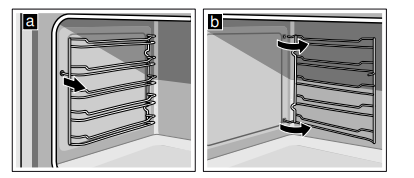
Inserting the hook-in rack
- Hold the catalytic cooking compartment panel in place.
- Insert the hooks of the hook-in rack into the rear holes in the side panel.
- Press the front hook of the hook-in rack into the hole.
Before Calling for Service
Before calling customer service, consider the suggestions and instructions below:
WARNING
RISK OF ELECTRIC SHOCK
Incorrect repairs are dangerous.Repairs must only be carried out by one of our trained customer service technicians.
Incorrect repairs to your appliance may present considerable risks for the user.
| Fault | Possible cause | Notes/remedy |
| The appliance does not work. |
Faulty fuse Power failure |
Look in the fuse box and check that the circuit breaker for the range is in working order. Check whether the kitchen light works. |
| The oven cannot be switched off. | Electronics are faulty | Switch off the circuit breaker. Call customer service. |
| The clock display flashes | Power failure | Reset the clock. |
| The oven does not heat. |
Faulty fuse Function selector not set |
Check the fuse and replace if necessary Set the function selector. |
| The door glass is broken. | Switch off the appliance. Call customer service. | |
| Fruit juice or albumen stains on enameled surfaces. | Moist cake or meat juices | Harmless change in the enamel, cannot be removed. |
| The oven stops operating in the middle of a program, and the cooling fan continues to run at high speed even when function selector is set to Off position. The buzzer sounds intermittently and the control lamp is flashing | Problem with thermostat |
|
Replacing the oven light bulb
If the oven light bulb fails, it must be replaced. Replacement heat-resistant bulbs can be obtained from customer service or from specialist retailers. Please supply your appliance's E number and FD number. Do not use any other type of bulb.
CAUTION
WHEN REPLACING AN OVEN LIGHT:
- Make sure the appliance and lights are cool and power to the appliance has been turned off before replacing the light bulb(s). Failure to do so could result in electrical shock or burns.
- The lenses must be in place when using the appliance.
- The lenses serve to protect the light bulb from breaking.
- The lenses are made of glass. Handle carefully to avoid breaking. Broken glass could cause an injury.
- Light socket is live when door is open.
WARNING
Light socket is live when door is open if main power supply is not turned off.
- Unplug the appliance from the mains or switch off the circuit breaker in the fuse box.
- Allow the cooking compartment to cool down.
- Open the appliance door.
- Place a tea towel in the cooking compartment to prevent damage.
- Remove the hook-in racks.
- Remove the glass cover.To do this, open the glass cover at the front with your hand. Should you experience difficulties removing the glass cover, use a spoon to help.
- Remove the oven light bulb.

- Replace the oven light bulb with a bulb of the same type:
Voltage (V): 12 V;
Power: 20W;
Socket: G4
Temperature resistance: 570° F (300 °C) - Refit the glass cover for the oven light bulb.
- Refit the hook-in racks.
- Remove the tea towel.
- Switch the circuit breaker back on.
- Check that the oven lighting is working again.
Tips for using your appliance
Here you will find a selection of tips about cookware and preparation methods.
Notes
- Use the accessories provided. Additional accessories may be obtained as optional accessories from specialist retailers or from customer service. Before using the oven, remove any unnecessary accessories and cookware from the cooking compartment.
- Always use oven gloves when taking hot accessories or cookware out of the cooking compartment.
Baking
Baking tins
- Use light-colored baking tins and trays wherever possible.
- Always place the baking tins on the middle of the baking and roasting wire rack.
Baking tips
| How to tell whether sponge cake is baked through. | Approx. 10 minutes before the end of the baking time stated in the recipe, insert a toothpick into the cake at its deepest point. If the toothpick comes out clean, the cake is ready. |
| The cake collapses. | Use less fluid next time or set the oven temperature 50°F (10°C) lower. Observe the specified mixing times in the recipe. |
| The cake has risen in the middle but is lower around the edge. | Do not grease the sides of the springform cake tin. After baking, loosen the cake carefully with a knife. |
| The cake browns too much on top. | Place it lower in the oven, select a lower temperature and bake the cake for a little longer. |
| The cake is too dry | When it is done, make small holes in the cake using a toothpick. Then drizzle fruit juice or an alcoholic beverage over it. Next time, set the temperature 50°F (10°C) higher and reduce the baking time. |
| The bread or cake (e.g. cheesecake) looks good but is sticky on the inside (soggy with wet streaks). | Use slightly less fluid next time and bake for slightly longer at a lower temperature. For cakes with a moist topping, bake the base first. Sprinkle it with almonds or bread crumbs and then place the topping on top. Please follow the recipe and baking times. |
| The cake is unevenly browned. | Select a slightly lower temperature to ensure that the cake is baked more evenly. Excess greaseproof paper can affect the air circulation. For this reason, always trim greaseproof paper to fit the baking tray. |
| The bottom of a cake topped with fruit is too light. | Place the cake one level lower the next time. |
| The fruit juice overflows | Next time, use the deeper universal pan, if you have one. |
| Small baked items made out of yeast dough stick to one another during baking. | There should be a gap of approx. 2 cm around each item. This gives enough space for the baked items to expand and turn brown on all sides. |
| Condensation forms when you bake moist cakes. | Baking may create water vapor, which escapes above the door. The steam may settle and form water droplets on the control panel or on the fronts of adjacent units. This is a natural process. |
Roasting and broiling
Cookware
You may use any heat-resistant cookware. Always place the cookware in the center of the wire rack. The enameled baking tray is also suitable for large roasts.
Roasting tips
- A lower temperature results in more even browning.
- Depending on the size of the meat, add 2 or 3 tablespoons of liquid to lean meat and 8 to 10 tablespoons of liquid to pot roasts.
- When cooking duck or goose, pierce the skin on the underside of the wings to allow the fat to run out.
- Poultry will turn out particularly crispy and brown if you baste it towards the end of the roasting time with butter, salted water or orange juice.
- Turn pieces of meat halfway through the cooking time.
- When the roast is ready, turn off the oven and allow it to rest for an additional 10 minutes. This will allow the meat juices to distribute themselves better inside the roast.
- When roasting large pieces of meat, you may find that the amount of steam and condensation on the oven door is more than usual. This is a normal occurrence that has no effect on the oven's performance. Once roasting is complete, dry the oven door and window with a cloth.
- If you are roasting on the wire rack, insert the enameled baking tray into shelf position 1 to collect the drips of fat.
Roasting tips
| How can you tell when the roast is ready? | Use a meat thermometer (available from specialist shops) or carry out a “spoon test.” Press down on the roast with a spoon. If it feels firm, it is ready.If the spoon can be pressed in, it needs to be cooked for a little longer. |
| The roast is too dark and the crackling is partly burnt. | Check the shelf position and temperature. |
| The roast looks good but the juices are burnt. | Next time, use a smaller roasting dish and add more liquid. |
| The roast looks good but the juices are too clear and watery. | Next time, use a larger roasting dish and use less liquid. |
Broiling tips
- As far as possible, the pieces of food you are broiling should be of equal thickness. They should be at least 1 inch thick. This will allow them to brown evenly and remain succulent and juicy.
- Place the food to be broiled in the center of the wire rack. Pour a little water into the enameled baking tray and insert this into the shelf position underneath the broil element to collect the drips of fat. Never place it on the cooking compartment floor.
- Drizzle some oil over the food to be broiled before you place it on the wire rack under the broil element.
- If the food to be broiled is thin, turn it over halfway through broiling; if it is thick, turn it over several times during broiling. Use tongs when turning the food to avoid piercing it and, in the case of meat, to keep the meat juices inside the meat.
- Dark meats such as lamb and beef brown better and more quickly than light meats such as pork and veal.
